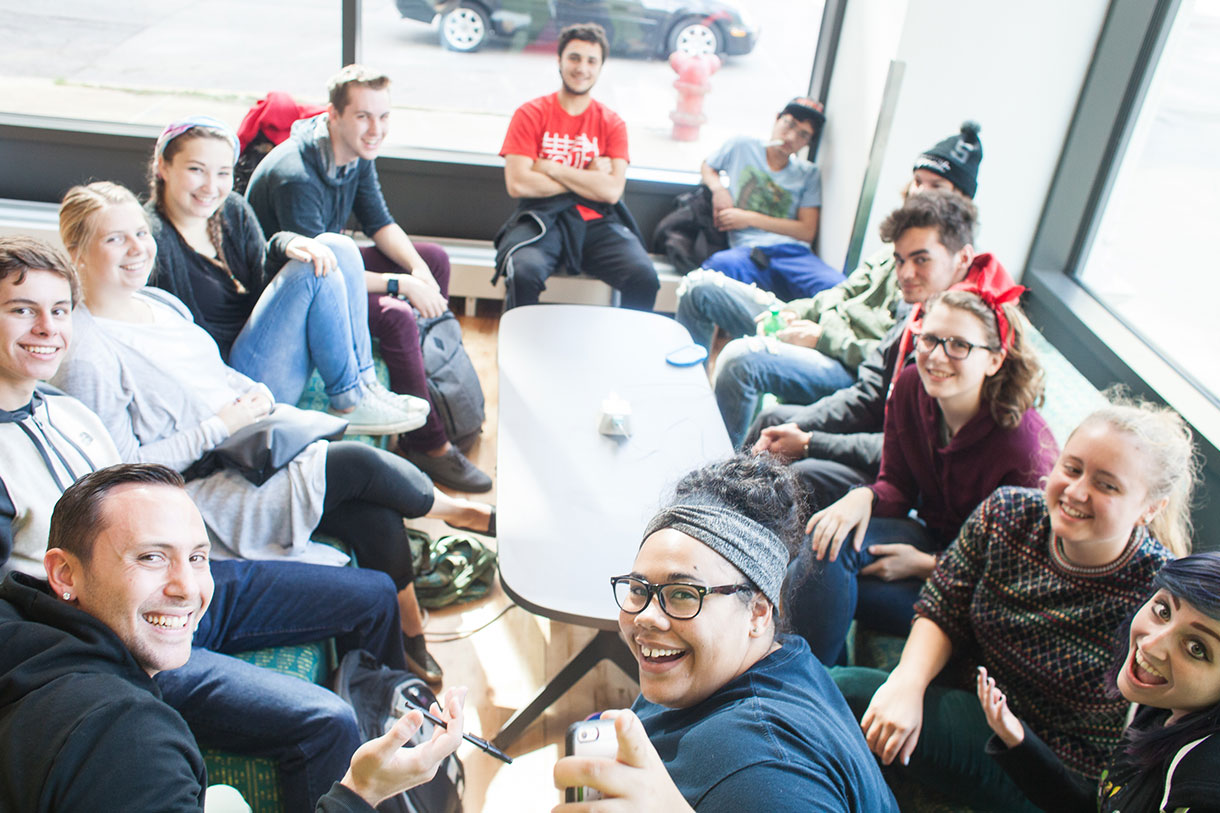“Big Chicago” First-Semester Experience Makes Big Connections
 Photo by Phil Dembinski
Photo by Phil DembinskiIncoming students at Columbia College have started their coursework this year with a new first-semester experience designed to integrate their studies within the landscape and culture of Chicago. The first-semester experience courses offer 14 “Big Chicago” areas of study (16 classes total) in large-lecture format along with breakout sessions done in partnership with New Student Commons (NSC). Ambitious ideas are the backbone of these courses, with compelling and substantive topics, including:
- Chicago – The Global Metropolis (Professor Dominic A. Pacyga)
- Fashion in Chicagoland: Vintage, Thrift, Fast and Cool (Assistant Professor Elizabeth Shorrock)
- Music and Media in Chicago (Lecturer Jim DeRogatis)
- Curiosity in the City: Monsters, Marvels, and Museums (Professor Stephen Asma)
- 50 Years of Civil Rights in Chicago (Associate Professor Alton Miller)
- Heard in the Hood: Social Media Storytelling from Chicago’s Neighborhoods (Assistant Professor Jackie Spinner)
- Podcasting Chicago: Capturing the Sounds of Chicago’s Neighborhoods (Associate Professor David Berner)
- Chicago Film History (Associate Professor Karla Fuller)
- Flagships, Boutiques, Popups and More: Chicago, A Retail Innovation Lab (Assistant Professor Peg Murphy)
- Chicago Means Business: The Creative Leadership of Our City (Lecturer Clayton Smith)
- Big Chicago: Dance, Sex and Popular Culture (Assistant Professor Raquel Monroe)
- Did You Know Al Capone’s Son Was Deaf? A View Inside the Deaf World in Chicago (Associate Professor Peter Cook and the American Sign Language Department)
- The Late, Late Afternoon Show (Assistant Professor Duncan Mackenzie)
- Chicago: Creating a Cinematic Diary (Associate Professor Don Smith)
To supplement the courses, NSC breakout sessions allow students to separate into small groups led by orientation leaders. Scheduled at the same time for every student on Fridays, the NSC activities set aside class time for students to collaborate on larger projects and investigate Chicago’s history, culture and visual landscape.
For example, in Professor Stephen Asma’s philosophy course, “Curiosity in the City: Monsters, Marvels, and Museums,” students travel to the city’s small shops, area collections and museums to write dispatches from the field. Assistant Professor Jackie Spinner’s class, “Heard in the Hood: Social Media Storytelling from Chicago’s Neighborhoods,” utilizes social media to engage with storytelling and to address larger topics in reporting and journalism.
“I’m running this as a newsroom in some respect and giving students from all majors a chance to learn how journalists use social media to tell stories,” said Spinner. “My hope is that they will not only get to tell their own stories but also be savvier consumers of news and the flood of images, videos and posts they see on social media.”
By giving students access to a plethora of topics at a depth and expanse otherwise challenging to accommodate on a smaller scale, the courses provide a shared experience for the incoming class as a whole. The new format also seeks to capitalize on the connective and explorative possibilities on a large scale, incorporating technology, such as social media and other digital platforms, to engage in dialogue and feedback in real time. The added layer of NSC sessions also provides more exploratory depth into various subject matters.
“Most Fridays my students are out in their neighborhoods telling stories on a variety of social media platforms. I’ve talked to other educators about what I’m doing and they can’t believe that I’m actually able to pull it off with the number of students I have,” Spinner says.
“We’ve been able to get into some substantial philosophical territory,” Asma says. “I’m very happy with the course so far, and I think it’s quite successful.”
The “Big Chicago” courses seek to align the college with current national standards at institutions of higher education by placing incoming freshman under the guidance of notable full-time faculty and asking students to deploy critical lenses outside of their major or field of study. Students taking “Did You Know That Al Capone’s Son Was Deaf?” a course team-taught by the faculty of the Department of American Sign Language (ASL), are asked to consider life from the perspective of Chicago’s Deaf community.
“What I am enjoying most about teaching the Big Chicago course is seeing it spark students’ interests in subjects that they might have never considered before,” says Associate Professor Diana Gorman Jamrozik. “I have had students come up after class wanting to know more about ASL, linguistics in general, and issues that Deaf people face on a daily basis.”
The opportunity for students to network and interact “in-the-field” at the core of the pilot program’s curriculum is buttressed by online discussions moderated by teaching assistants using the college’s Moodle platform and a new student response system, GoSoapBox. The presence of teaching assistants give incoming students and lecturers extra support inside and outside of the classroom and permit Columbia’s graduate students and upperclassmen more opportunities to build their resumes and gain teaching experience.
Conversations about revising the previous First-Year Seminar program have been ongoing since at least 2005, which included continued feedback from students that both recognized the value the introductory course provided and the need for a more robust experience. As the new Strategic Plan took shape in early 2015 with universal learning outcomes as one of its primary goals, the opportunity arose to reshape the program.
As the "Big Chicago" pilot continues, all faculty who aided in constructing the classes this semester will continue to advise in First-Semester Experience development.